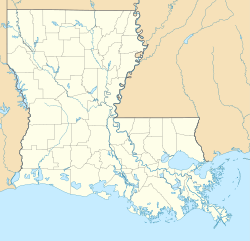|
Robert "Bob" Hicks House
The Robert Hicks House, in Bogalusa, Louisiana, was the home from 1965 to 1969 of civil rights leader Bob Hicks (1929–2010) and the site of civil rights meetings in the city.[2] The house, built in the early 1950s, is a one-story 1,590 sq ft (148 m2) building with similarities to 1950s ranch houses and 1930s bungalows. It has weatherboard siding and is built on concrete piers. The property also includes a 1906-built "mill house" built by the Great Southern Lumber Company when it developed the company town of Bogalusa from the ground up in 1906–1907. HistoryHicks was a co-founder and leader of the local chapter of the Deacons for Defense and Justice, founded in February 1965 and affiliated with the original group founded in Jonesboro, Louisiana. They organized men for armed self-defense in order to protect civil rights activists and their families, under attack in those years by the Ku Klux Klan. He was also a leader of the Bogalusa Civic and Voters League (BCVL), which was seeking to register black voters. The house was listed on the National Register of Historic Places in 2015.[1] It was deemed significant for its role in the Civil Rights Movement in Bogalusa and for its association with leader Robert Hicks. The house served as the headquarters for the executive board of the BCVL, and for the Deacons for Defense and Justice.[1] On February 1, 1965, the house was threatened with bombing by whites seeking to intimidate the activists of the BCVL.[3] On February 21, 1965, Hicks and others founded the local chapter of the Deacons for Defense and Justice to protect activists and their families. On May 17, 1965, Hicks participated in an attempt by blacks to use one of Bogalusa's public parks. Despite passage the previous year of the national Civil Rights Act of 1964, prohibiting segregation of public facilities, local whites continued to exclude blacks from parks and other places.[2] Confrontations continued through the summer and in July 1965, the federal government used Reconstruction-era law to order the local police to protect the civil rights activists.[3] A historic plaque was erected at the house site. The Robert Hicks Foundation is supporting work for a civil rights museum at the site.[4][5] Text of the markerFront:
Reverse:
See also
References
Further reading
External links
|
||||||||||||||||||
Portal di Ensiklopedia Dunia



